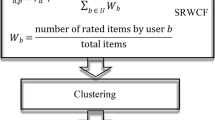Abstract
Recommendation systems are essential tools for piquing consumers’ interests and stimulating consumption in today’s electronic commerce, and the quality of these systems depends on the employed filtering algorithms. Therefore, improving the performance of these algorithms is an important issue. In this paper, we design an intensity-based contraction (IC) algorithm that works in combination with other machine-learning algorithms in model-based collaborative filtering, which is currently the most popular filtering algorithm. The main challenges for this algorithm are sparseness of the database and lack of scalability. To demonstrate how IC is used, we implemented IC clustering as an example, which can effectively reduce the sparseness of the database and improve the efficiency. Moreover, we created a scalable IC on a MapReduce model, the scalability of which is demonstrated with actual experiments.









Similar content being viewed by others
References
Arnold K, Gosling J, Holmes D (1996) The Java programming language, vol 2. Addison-Wesley, Reading
Bachwani R, Crameri O, Bianchini R, Zwaenepoel W (2013) Mojave: a recommendation system for software upgrades. In: Presented as part of the 2013 USENIX annual technical conference (USENIX ATC 13), pp 219–230
Basu C, Hirsh H, Cohen W et al (1998) Recommendation as classification: using social and content-based information in recommendation. In: AAAI/IAAI, pp 714–720
Bennett J, Lanning S (2007) The netflix prize. In: Proceedings of KDD cup and workshop, vol 2007, p 35
Bobadilla J, Ortega F, Hernando A, Bernal J (2012) A collaborative filtering approach to mitigate the new user cold start problem. Knowl Based Syst 26:225–238
Cacheda F, Carneiro V, Fernández D, Formoso V (2011) Comparison of collaborative filtering algorithms: limitations of current techniques and proposals for scalable, high-performance recommender systems. ACM Trans Web (TWEB) 5(1):2
Calandrino JA, Kilzer A, Narayanan A, Felten EW, Shmatikov V (2011) “You might also like:” privacy risks of collaborative filtering. In: 2011 IEEE symposium on security and privacy (SP), pp 231–246
Carullo G, Castiglione A, De Santis A, Palmieri F (2015) A triadic closure and homophily-based recommendation system for online social networks. World Wide Web, pp 1–23
Chen R-C, Huang Y-H, Bau C-T, Chen S-M (2012) A recommendation system based on domain ontology and SWRL for anti-diabetic drugs selection. Expert Syst Appl 39(4):3995–4006
Cleger-Tamayo S, Fernández-Luna JM, Huete JF (2011) A new criteria for selecting neighbourhood in memory-based recommender systems. In: Advances in artificial intelligence, pp 423–432. Springer, New York
Cui C-S, Qi-Zong W (2010) Research on content-based recommendation based on vague sets. Appl Res Comput 6:035
Dean J, Ghemawat S (2008) Mapreduce: simplified data processing on large clusters. Commun ACM 51(1):107–113
Di Noia T, Mirizzi R, Ostuni VC, Romito D (2012) Exploiting the web of data in model-based recommender systems. In: Proceedings of the sixth ACM conference on recommender systems, pp 253–256. ACM, New York
Durao F, Dolog P (2014) Improving tag-based recommendation with the collaborative value of wiki pages for knowledge sharing. J Ambient Intell Hum Comput 5(1):21–38
Fernández-Tobías I, Campos PG, Cantador I, Díez F (2013) A contextual modeling approach for model-based recommender systems. In: Advances in artificial intelligence, pp 42–51. Springer, New York
Funakoshi K, Ohguro T (2000) A content-based collaborative recommender system with detailed use of evaluations. In: Proceedings of the fourth international conference on knowledge-based intelligent engineering systems and allied technologies, vol 1, pp 253–256. IEEE, New York
Gavalas D, Kenteris M (2011) A web-based pervasive recommendation system for mobile tourist guides. Pers Ubiquitous Comput 15(7):759–770
Imran K, Ghauth B, Abdullah NA (2011) The effect of incorporating good learners’ ratings in e-learning content-based recommender system. Educ Technol Soc 14(2):248–257
Gong SJ (2011) Research on item model in content-based filtering recommender systems. Key Eng Mater 480:1235–1239
Guo B, Zhang D, Zhiwen Y, Calabrese F (2014) Extracting social and community intelligence from digital footprints. J Ambient Intell Hum Comput 5(1):1–2
Hsu F-M, Lin Y-T, Ho T-K (2012) Design and implementation of an intelligent recommendation system for tourist attractions: the integration of ebm model, bayesian network and google maps. Expert Syst Appl 39(3):3257–3264
Jalali M, Mustapha N, Sulaiman MN, Mamat A (2010) Webpum: a web-based recommendation system to predict user future movements. Expert Syst Appl 37(9):6201–6212
Jiang Y, Shang J, Liu Y (2010) Maximizing customer satisfaction through an online recommendation system: a novel associative classification model. Decis support Syst 48(3):470–479
Jung K-Y, Park D-H, Lee J-H (2004) Hybrid collaborative filtering and content-based filtering for improved recommender system. In: Computational science—ICCS 2004, pp 295–302. Springer, New York
Koren Y (2010) Factor in the neighbors: scalable and accurate collaborative filtering. ACM Trans Knowl Discov Data (TKDD) 4(1):1
Liu F, Lee HJ (2010) Use of social network information to enhance collaborative filtering performance. Expert Syst Appl 37(7):4772–4778
Lops P, De Gemmis M, Semeraro G (2011) Content-based recommender systems: state of the art and trends. In: Recommender systems handbook, pp 73–105. Springer, New York
Shvachko K, Kuang H, Radia S, Chansler R (2010) The hadoop distributed file system. In: 2010 IEEE 26th symposium on mass storage systems and technologies (MSST), pp 1–10. IEEE, New York
Wang S-L, Chun-Yi W (2011) Application of context-aware and personalized recommendation to implement an adaptive ubiquitous learning system. Expert Syst Appl 38(9):10831–10838
White T (2009) Hadoop: the definitive guide: the definitive guide. O’Reilly Media, Sebastopol
Yang S-H, Long B, Smola AJ, Zha H, Zheng Z (2011) Collaborative competitive filtering: learning recommender using context of user choice. In: Proceedings of the 34th international ACM SIGIR conference on research and development in information retrieval, pp 295–304. ACM, New York
Zheng VW, Cao B, Zheng Y, Xie X, Yang Q (2010) Collaborative filtering meets mobile recommendation: a user-centered approach. In: AAAI, vol 10, pp 236–241
Acknowledgments
This work was supported by National Natural Science Foundation of China (No.61170268).
Author information
Authors and Affiliations
Corresponding author
Additional information
Z. Liu and B. Cui contribute to this work equally.
Rights and permissions
About this article
Cite this article
Cui, B., Jin, H., Liu, Z. et al. Improved collaborative filtering with intensity-based contraction. J Ambient Intell Human Comput 6, 661–674 (2015). https://doi.org/10.1007/s12652-015-0284-9
Received:
Accepted:
Published:
Issue Date:
DOI: https://doi.org/10.1007/s12652-015-0284-9




